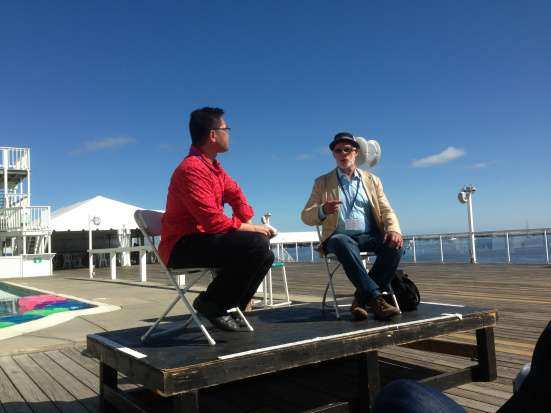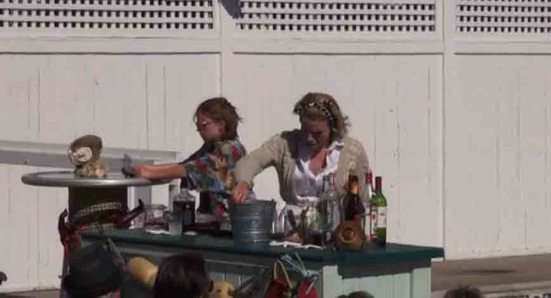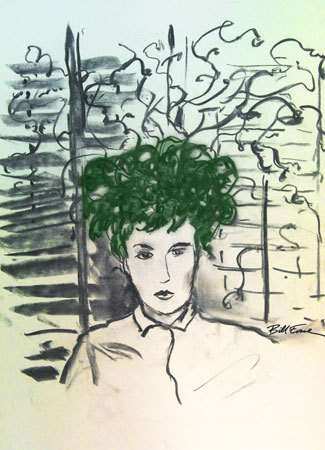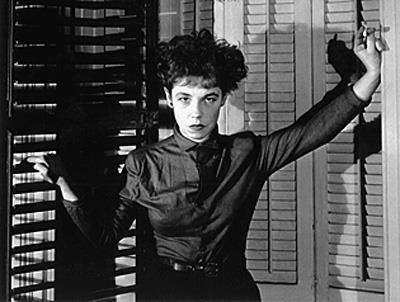Scenes from a festival workshop production of In the Summer House from LIPTV 5 on Vimeo.
PROVINCETOWN | You’ve likely not heard of Jane Bowles, but she wrote a cock-eyed, mesmerizing play that was one of the signal achievements of postwar American drama. It’s right up there with the classic works of Arthur Miller, Tennessee Williams, Gertrude Stein, late Eugene O’Neill, Lillian Hellman, and Sam Shepard.
This post is about that unjustly neglected play: In the Summer House.
It’s not that difficult to become a literary expert on Jane Bowles. She wrote one novel, one play (two if you include a six-page puppet play), and seven meticulously crafted short stories. Her total output was tiny. Yet what she did leave behind was beyond brilliant.
It’s not that difficult either to be enamored with her biography. She lived an out-sized life, an unhappy one, if you believe the conventional wisdom, but it’s the stuff dramas are made of. She was Jewish, homosexual, alcoholic, a communist, a cripple, a cult figure, the platonic wife of the gay writer and composer Paul Bowles (The Sheltering Sky), and a fascinating pole star in a literary coterie that included Tennessee Williams, Gertrude Stein, Djuna Barnes and later such Beat Generation types as William Burroughs and Allen Ginsburg.
Like Gertrude Stein (the formalist who altered the face of the American drama), Bowles had for years enjoyed an underground reputation among artists. When she died in 1973, the poet John Ashberry classified her in a New York Times obit as “a writer’s writer’s writer.” It’s the accursed designation that stuck, even though Ashberry did go further. He wrote, “It is to be hoped that she will be recognized for what she is: one of the finest modern writers of fiction in any language.”
Her friend Tennessee Williams had long been hitting the drumbeat for Bowles. He called her “the most important writer of prose fiction in Modern American letters.”
The work of a maverick
Bowles was so much more than a fiction writer raised to the third power. She was a maverick. On the strength of one full-length play, she had set her own place in the pantheon of post-war American drama. She did it in her own highly individualistic way. In the Summer House, although rarely produced today, is so exquisite and so original that it has taken us (well, it is still taking us) a long time to catch up with its odd dazzle.
The idea of affirming it as a singular work of postwar American theater was, in part, why I came to the Provincetown Tennessee Williams Theater Festival. As moderator, I joined the festival’s curator David Kaplan in a post-performance discussion on Sunday, September 29. Kaplan devised this year’s festival theme of “Williams and Women.” His contribution? He himself staged Act 2 of In the Summer House on the pool deck of the Boatslip, facing the Atlantic Ocean, on Friday Sept. 27 and on Sunday Sept. 29.
Why not stage the whole play? I journeyed to America’s land’s end to find out.
It was very much a workshop production. In our public conversation on the pool deck of the Boatslip, Kaplan said that for him, a question hangs over the Bowles’s text. Tennessee Williams loved this play. Why?
Williams read the first act in 1940. He helped Bowles obtain a grant to get the second act written. He traveled in 1956 to Ann Arbor, Michigan, to see the play performed. He gave it blurbs and consistent praise in interviews and in his Memoirs. Why?
Kaplan’s answer was to stage an experiment. Viewing In the Summer House through the prism of Williams’s sensibility, this workshop production tries to answer Kaplan’s quizzical questions by picking up the play’s story in Act 2 and then doubling back on a fragment of Act 1. To help him explore, the rabbinical director used actors from past festival productions of Orpheus Descending (TW Fest 2010 and 2011): Irene Glezos as Mrs. Eastman-Cuevas, Brenda Currin as Mrs. Constable and Beth Bartley as Ines.
What Kaplan has been doing is to lay bare (for himself and his actors) the narrative structures and character motivations of a text that he confesses seems inscrutable. That’s because In the Summer House is packed with idiosyncrasies. Stylistically Jane Bowles resembles her own heroine, Miss Goering, in Two Serious Ladies. At one point in this strange, entrancing novel, a character complains to Miss Goering, “You can never sit down for more than five minutes without introducing something weird into the conversation. I certainly think you have made a study of it.”
So does In the Summer House. It makes a screwball study of being wild and peculiar. Dramaturgically, it balances a refined, decorous naturalism with a modernist attentiveness to the incongruous or repressed inner life. In the Summer House does not work in the conventional sense. Its dialogue lures you to dig deeper into the characters’ inner workings even as it refuses to yield anything further. It vibrates within that kinetic space.
It was not for nothing that Bowles had felt that perhaps Charlie Chaplin might have been the only director capable enough to stage her play. With its odd involutions and surprising turns, her sense of the dramatic relies a great deal on unresolved ambiguity in both character and action. What makes her play theatrical and highly original is that it challenges audiences to create a narrative logic that avoids reduction to common cliches.
An expert on strangeness and human apartness
In the Summer House is a play about mothers and daughters: about “serious ladies” who are frequently nervous or uncomfortable in their own skin, even when they are domineering. Bowles was 30 years old in 1947, the year she completed Act 1 of the play and published it in Harper’s Bazaar. By then, she had been writing fiction for at least a decade. Her fictional narratives repeatedly returned to relationships between women. She was “an expert on strangeness,” as the writer Janet Mason observes, adding:
Most of her stories, if not all, explore both the entanglements and estrangement inherent in the claustrophobia of intimacy. In the introduction, Truman Capote refers to this as “human apartness.”
Unlike Williams, who was himself a poet of human apartness, Bowles’s focus was not always with her women characters’s sexual lives. Invariably she explored women’s conflicting experiences to bind themselves to and escape from one another — to serve and to command.
In Summer House, there are three sets of mothers and daughters. Each pair struggles to maintain the emotional closeness between them and to separate from one another’s clutches. Whereas in Williams’s The Glass Menagerie the smothering mother comes across as a kind of sacred monster, in Bowles’s Summer House, mothers take control and domineer, but the true power rests with their daughters.

Provincetown Tennessee Williams Theater Festival: Me and David Kaplan on the pool deck of the Boatslip discussing Jane Bowles’s “In the Summer House”
Seeing Act 2 alone turns out to be quite a fascinating exercise for those of us who have seen the entire play with the scenes in their original order. It forced me to look at Act 2 anew and with fresher eyes. In the past critics have generally found the second act to be less successful than the first act. To prove their point, they point to the fact that Bowles had devised three endings for the play. (The published ending is the classic scenario in popular melodrama where the young woman runs out with the man.) During the original Broadway production in 1953, according to Bowles’s biographer Millicent Dillon, “a psychiatrist was brought in to explain the motivation of the play.”
The potential of an innovative new take
The surprise in Kaplan’s entertaining presentation is that Act 2 (with a little help from a piece of Act 1) stands on its melodramatic own. Staged around a pool at the Boatslip and making wonderful theater out of the yawning distance (both literal and psychological) between characters, Act 2 works as a great teaser. It whetted mine and the audiences’ appetite to see more of the play.
Next year Kaplan will return to Provincetown. He will stage a site-specific production of In the Summer House. He said he will push forward with his idea of reversing those two Acts, although he did quickly add that he will give Bowles her due by offering some performances that preserve the original order.
“I owe it to her to do it the way she wrote it,” Kaplan told me.

Provincetown Tennessee Williams Theater Festival: workshop production of Jane Bowles’s “In the Summer House” on the pool deck of the Boatslip
The prospect of participating in what promises to be an innovative new take of In the Summer House was the other great reason to go the annual Provincetown Tennessee Williams Theater Festival. Bowles’s unpredictable work has never received significant popular attention. Here was an opportunity to get involved in this unique festival’s stronghold: its ardent mission of offering fresh new discoveries from the Williams canon and that of his contemporaries.
Eight years since it was first established, the festival has rejuvenated Williams’s later plays and his more experimental works, those commercially unsuccessful plays which the critics have consistently relegated to the dustbin of the work of a failed drug-addled alcoholic.
What this festival has done and is continuing to do in terms of revivifying the late, strange Williams works, perhaps it can do as well to Jane Bowles’s strange, singular In the Summer House. -rg
Video recording of my In the Summer House Q&A with David Kaplan from LIPTV 2 on Vimeo.
Related articles
- Women at heart of upcoming Tennessee Williams theater fest in Provincetown (wickedlocal.com)
- Tennessee Williams festival explores women and illusion (hispanicbusiness.com)
- Gertrude Stein (barrickmuseum.wordpress.com)
- Breaking Good: Broadway’s Golden Age Reborn on Cable (themillions.com)
- Tennessee William’s Time is Now (perf570.wordpress.com)
- Tennessee Williams Tribute Festival begins (miamiherald.com)
- Zachary Quinto Is Brilliant On Broadway (buzzfeed.com)
- Tennessee Williams’ Laurel Wreath On Display In Columbus, Miss. (thisisrealmedia.com)
- An American Masterpiece, And A ‘Menagerie’ Of Stars (npr.org)
- Not Radical, but Gnarly Revision ~ (petearagones.wordpress.com)




I’ve read about Jane Bowles and her hubby, Paul. Thanks for article. I did a posting for Arthur Miller’s birthday today, please stop by and visit some time.! Thanks!